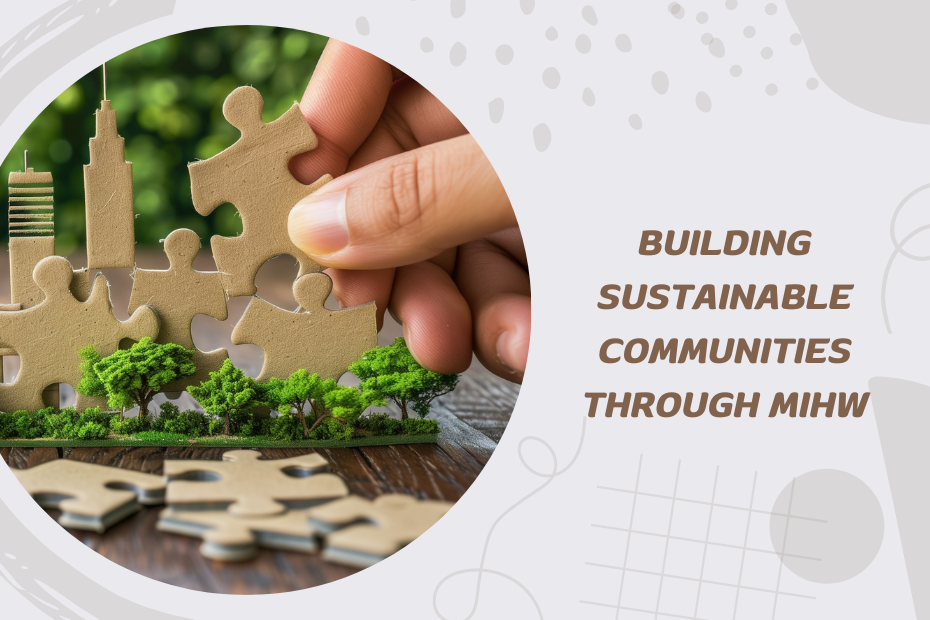Building sustainable communities is an intricate process that integrates environmental stewardship, social equity, economic viability, community health, education, engagement, and technological innovation. MIHW, which stands for “Maintaining Integrated Healthy Ways,” is an approach dedicated to fostering resilience, inclusivity, and long-term prosperity in communities. This article explores various strategies and practices essential for building sustainable communities through MIHW, providing a comprehensive overview of how these methods can be effectively applied. By examining these elements in detail, stakeholders can implement solutions that promote sustainability at every level of community development, ensuring a healthier and more vibrant living environment for all residents.
The Role of Environmental Stewardship
Environmental stewardship is a fundamental aspect of building sustainable communities. This involves the careful management of natural resources to ensure their availability for future generations. Sustainable urban planning is a crucial component, encompassing green building practices, the integration of renewable energy sources, and the creation of green infrastructure. Green buildings are designed to reduce energy consumption, minimize waste, and enhance the well-being of occupants. Features such as energy-efficient lighting, water-saving fixtures, and sustainable materials contribute to lower environmental impact and operational costs. Urban green spaces, including parks, green roofs, and urban forests, play a significant role in reducing urban heat islands, managing stormwater, and enhancing biodiversity.
Additionally, promoting renewable energy sources such as solar, wind, and geothermal energy is vital for reducing carbon footprints and ensuring sustainable energy supply. Renewable energy not only reduces greenhouse gas emissions but also provides long-term economic benefits by reducing reliance on fossil fuels and creating green jobs. Community-based renewable energy projects, such as solar cooperatives and wind farms, empower residents to take an active role in sustainability efforts and benefit directly from clean energy production. By prioritizing environmental health and sustainability, communities can enhance their resilience to climate change and reduce their overall environmental impact.
Social Equity and Inclusion
Social equity and inclusion are critical to the MIHW approach, ensuring that all residents have access to essential services, opportunities, and a high quality of life. Building sustainable communities requires addressing disparities and promoting inclusivity across all aspects of community life. This involves creating affordable housing, ensuring access to quality education and healthcare, and fostering social cohesion through community engagement initiatives. Affordable housing is essential for providing stable living conditions and preventing displacement. Programs that offer financial assistance, rent control, and the development of mixed-income housing help maintain diversity and inclusivity in communities.
Quality education is another cornerstone of social equity. Providing access to early childhood education, improving public school systems, and offering adult education and vocational training programs are essential for empowering residents and fostering economic mobility. Healthcare access is equally important, with initiatives aimed at ensuring affordable and comprehensive healthcare services for all, including preventive care, mental health services, and support for chronic conditions. Community health programs that address specific needs, such as substance abuse prevention and maternal health, contribute to overall well-being and resilience. Additionally, engaging residents in community planning and decision-making processes ensures that development projects reflect the needs and aspirations of the community, fostering a sense of ownership and belonging.
Economic Viability and Local Prosperity
Economic viability is a fundamental component of sustainable communities, requiring the development of diverse, resilient local economies capable of providing stable employment opportunities. Supporting local businesses, encouraging entrepreneurship, and investing in sustainable industries are key strategies. Local businesses are the backbone of community economies, providing jobs and retaining wealth within the community. Initiatives such as small business grants, low-interest loans, and business incubators help support the growth and sustainability of local enterprises. Encouraging entrepreneurship, particularly among underrepresented groups, fosters innovation and economic diversity.
Sustainable industries, including renewable energy, sustainable agriculture, and green manufacturing, offer significant economic and environmental benefits. Investing in these sectors not only creates jobs but also contributes to long-term sustainability. For instance, promoting local food production through community gardens, urban farms, and farmers’ markets boosts local economies, improves food security, and reduces the environmental impact associated with long-distance food transport. Furthermore, providing training and education programs that equip residents with skills relevant to emerging green industries can drive economic growth and sustainability simultaneously. These initiatives ensure that economic development aligns with environmental and social goals, creating a holistic approach to community prosperity.
Community Health and Wellness
Community health and wellness are integral to the MIHW framework, emphasizing the importance of physical, mental, and social well-being. Sustainable communities prioritize the health of their residents through various initiatives aimed at creating safe, accessible, and healthy living environments. This includes the development of recreational spaces such as parks, trails, and community centers that promote physical activity and social interaction. Active transportation options, including walking and cycling paths, encourage healthier lifestyles and reduce reliance on automobiles, contributing to improved air quality and reduced greenhouse gas emissions.
Access to nutritious food is another critical aspect of community health. Initiatives such as community gardens, food co-ops, and farmers’ markets increase access to fresh, healthy food options and promote sustainable agriculture practices. Health and wellness programs that address specific community needs, such as mental health support, substance abuse prevention, and chronic disease management, are also crucial. These programs not only improve individual health outcomes but also enhance community resilience and productivity. By fostering environments that support healthy lifestyles, communities can improve overall well-being and contribute to long-term sustainability.
Education and Lifelong Learning
Education and lifelong learning are essential for building sustainable communities, ensuring that residents are equipped with the knowledge and skills needed to contribute to and benefit from sustainable development. Providing quality education from early childhood through adulthood is crucial for fostering a culture of environmental stewardship and social responsibility. Early childhood education programs lay the foundation for lifelong learning, while improvements in public school systems ensure that all children receive a quality education. Adult education and vocational training programs provide opportunities for continuous personal and professional growth, enabling residents to adapt to changing economic conditions and job markets.
Integrating sustainability into educational curricula helps instill values of environmental stewardship and social responsibility from a young age. Schools and educational institutions can serve as models of sustainability by incorporating green building practices, energy efficiency, and waste reduction measures. Additionally, community-based education programs, such as workshops and seminars on sustainability topics, provide valuable learning opportunities for residents of all ages. By prioritizing education and lifelong learning, communities can ensure that all residents are prepared to contribute to and benefit from sustainable development.
Community Engagement and Empowerment
Active community engagement and empowerment are crucial for the success of sustainable community initiatives. Encouraging residents to participate in decision-making processes ensures that development projects reflect the needs and aspirations of the community. This can be achieved through public consultations, participatory planning sessions, and the establishment of community advisory boards. Empowering residents to take an active role in sustainability initiatives, such as organizing local clean-up events, sustainability workshops, and community gardens, fosters a sense of ownership and accountability. Effective community engagement builds social capital, strengthens community bonds, and enhances the overall resilience of the community.
Creating platforms for community members to share their ideas, concerns, and feedback is essential for fostering a collaborative and inclusive environment. Digital platforms, social media, and community meetings can facilitate communication and ensure that all voices are heard. Additionally, developing leadership skills within the community through training and mentorship programs helps residents take on active roles in driving sustainability initiatives. By empowering individuals and groups within the community, sustainable practices can be more effectively implemented and maintained, leading to long-term success and resilience.
Technology and Innovation
Leveraging technology and innovation is critical for advancing sustainable community development. Smart city technologies, such as energy-efficient lighting, waste management systems, and real-time data monitoring, enhance urban efficiency and reduce environmental impacts. Innovations in building materials and construction methods, such as the use of recycled materials and modular construction, contribute to sustainable infrastructure development. Additionally, digital platforms can facilitate community engagement, providing residents with easy access to information and enabling them to participate in local governance. By embracing technological advancements, communities can achieve greater sustainability and improve the quality of life for their residents.
Emerging technologies, such as the Internet of Things (IoT), artificial intelligence (AI), and blockchain, offer new opportunities for enhancing sustainability efforts. IoT devices can monitor and optimize resource use, reducing waste and improving efficiency. AI can analyze data to identify patterns and provide insights for better decision-making. Blockchain technology can enhance transparency and trust in community transactions, such as energy trading and waste management. By integrating these technologies into community planning and management, sustainable practices can be more effectively implemented and scaled.
In conclusion, building sustainable communities through MIHW requires a holistic approach that integrates environmental stewardship, social equity, economic viability, community health, education, engagement, and technological innovation. By prioritizing these elements, communities can create resilient, inclusive, and vibrant living environments that support the well-being of all residents. The strategies discussed in this article provide a framework for stakeholders to implement effective and sustainable solutions that address the unique challenges and opportunities within their communities. As we move forward, embracing these principles will be essential for fostering sustainable development and ensuring a healthy and prosperous future for all. Sustainable communities are not just an ideal but a necessity in our rapidly changing world, and through collective efforts, we can make this vision a reality.

Thomas J. Powell is a distinguished Senior Advisor at Brehon Strategies and a recognized figure in the realm of entrepreneurship and private equity. His journey in the financial services and banking sector, starting in 1988 in Silicon Valley, spans more than 35 years and is marked by profound industry expertise. Powell’s dual citizenship in the European Union and the United States empowers him to adeptly steer through international business landscapes. Currently studying for his Doctor of Law and Policy at Northeastern University, his research is centered on addressing the shortage of middle-income workforce housing in rural resort areas. Alongside his professional pursuits, he remains committed to community enrichment, illustrated by his 45-year association with the Boys and Girls Clubs of America. Follow Thomas J Powell on Twitter, Linkedin etc.

